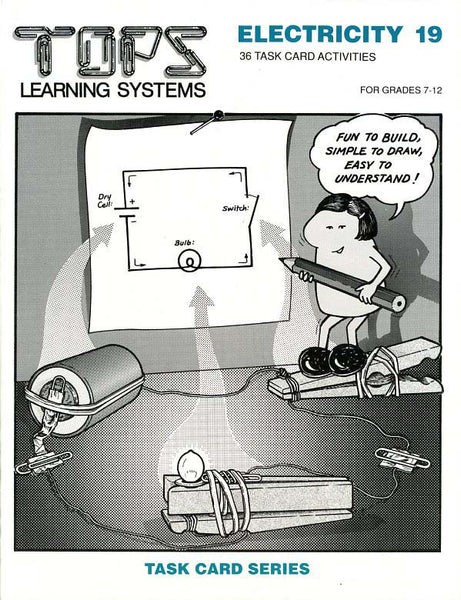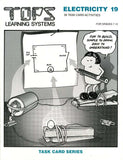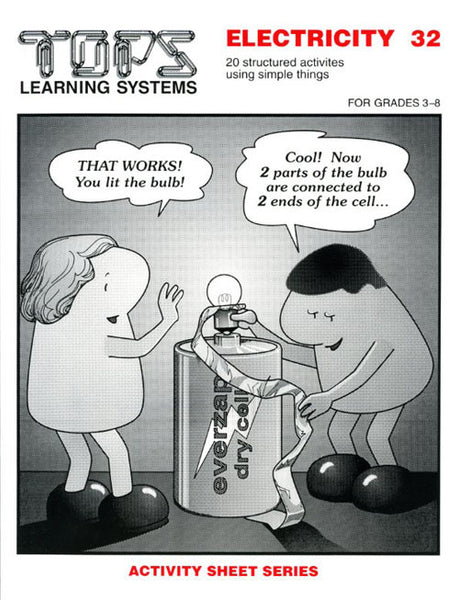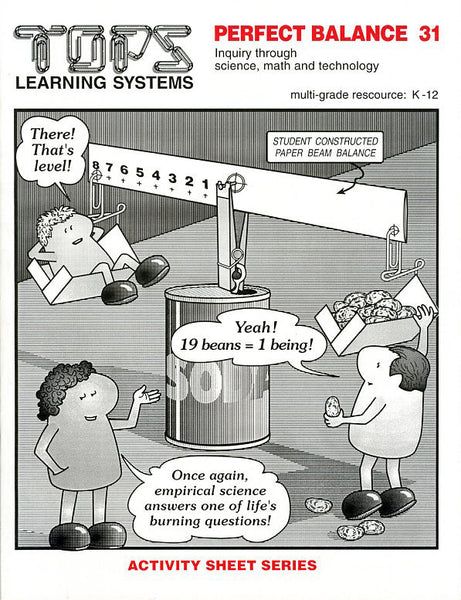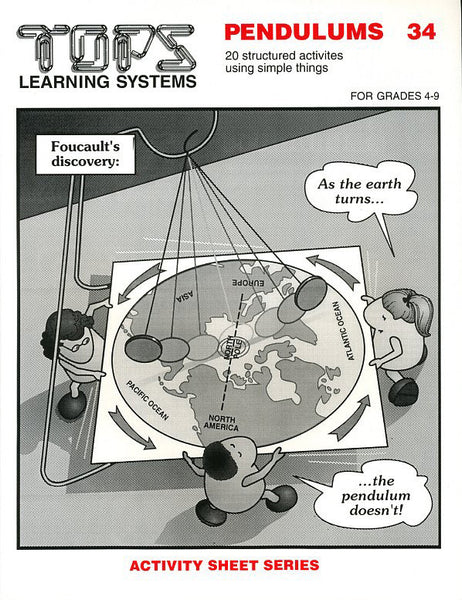#19 Electricity (grades 8-12)
Regular price $22.95
Soft-bound, 88 page book, 36 reproducible task cards, full teaching notes.
Probe the nature of like and unlike charges. Improvise bulb holders, battery holders and switches to configure parallel and series circuits. Predict current flow using Ohm’s law. Construct galvanometers, variable resistors, fuses, electroscopes, wet cells, storage cells and ammeters. Split water and recombine the gases in a safe mini-explosion!
Electricity Supplies
WE SUPPLY five hard-to-locate items: 5% HCl in a dropper bottle, six split-shot lead sinkers, one 2 1/2 inch galvanized nail, one 220 micro-Farad electrolytic capacitor, and two 100 ohm Resistor (1/2 watt). 2 flashlight bulbs YOU SUPPLY everything else.
More Information – click any of the tabs below to learn more about this title
Click here for a complete list of materials and convenient shopping.
spool thread, 10x10 cm silk cloth, masking tape, scissors, styrofoam cups or blocks, size-D batteries, copper wire, wire cutter, pennies, flashlight bulbs, straws, rubber bands, straight pins, tin cans nails, , rolls aluminum foil, paper punch, clothespins, paper clips, rulers, produce bags, meter sticks, wrapping wire, baby food jars, ceramic magnets, steel wool, index cards, cardboard, 5% hydrochloric acid, 100 mL beakers, test tubes, baking soda, matches, paper towels, plates or petri dishes,, 3% hydrogen peroxide, split-shot lead fishing sinkers, table salt, capacitors rated 0.1 farad or greater, oil based clay, 100 ohm resistors rated at 1/4 or 1/2 watt, commercial galvanometer or ammeter with milli-amp sensitivity, needed in 3 activities, vinegar, washers- Lesson 1: To understand electrostatic attraction between objects as a transfer of electrons.
- Lesson 2: To observe electrostatic repulsion and attraction between objects of like and unlike charge. To understand why electrons flow through a wire.
- Lesson 3: To discover, through trial and error, how to properly wire a circuit. To identify the important contact points on a dry cell and light bulb.
- Lesson 4: To classify materials as conductors or insulators. To understand how these are used in the design of a light bulb.
- Lesson 5: To induce a redistribution of charge in a neutral conductor. To charge and discharge by contact.
- Lesson 6: To observe and explain induced polarization in a stream of water and in solid insulators.
- Lesson 7: To polarize insulating and conducting circle punches in an electric field. To compare their charging and discharging characteristics.
- Lesson 8: To construct a bulb holder to use in all circuit-building activities.
- Lesson 9: To construct a cell holder to use in all circuit-building activities.
- Lesson 10: To construct a switch to use in all circuit-building activities. To build a simple circuit.
- Lesson 11: To develop a kinesthetic sense of current, voltage and resistance. To understand how these variables are interrelated by Ohm's law.
- Lesson 12: To develop a kinesthetic sense of current, voltage and resistance. To practice applying Ohm's law.
- Lesson 13: To diagram and build circuits in series. To explain current variations in terms of Ohm's law.
- Lesson 14: To diagram and build a parallel circuit. To understand the advantage of parallel wiring.
- Lesson 15: To discover that voltages add as cells are connected in series.
- Lesson 16: To build a double-throw switch that alternates current through two separate bulbs.
- Lesson 17: To build a set of two-way switches that independently operate a bulb.
- Lesson 18: To trace the flow of electricity through a complex maze of switches
- Lesson 19: To construct a sensitive galvanometer. To observe that moving electrons create an associated magnetic field.
- Lesson 20: To observe that galvanometers are sensitive to the direction that electrons flow through a wire. To use this property to determine the relative strengths of two dry cells.
- Lesson 21: To observe how current flows through wire in inverse proportion to its resistance, in accordance with Ohm's law.
- Lesson 22: To control currents in a circuit by operating a variable resistor. To understand that resistance increases as a wire's length increases.
- Lesson 23: To understand that resistance increases as a wire's diameter decreases. To add resistances in series and in parallel, then observe the combined effect.
- Lesson 24: To understand how fuses work to protect circuits from shorts and overloads.
- Lesson 25: To build an electroscope and learn to charge it. To explore various ways to discharge it.
- Lesson 26: To learn to identify the charge on an electroscope. To charge it by contact and by induction.
- Lesson 27: To observe how hydrogen ions accept electrons to form hydrogen gas, and chlorine ions release electrons to form chlorine gas.
- Lesson 28: To separate a test tube of water into oxygen and hydrogen gas.
- Lesson 29: To study how current separates water into its component gases. To release stored electrical energy by a chemical reaction.
- Lesson 30: To build a cell that converts chemical energy into electrical energy. To understand this process as the reverse of electrolysis.
- Lesson 31: To build a working model of a storage cell. To understand why charging and discharging the cell reverses current through the circuit.
- Lesson 32: To charge and discharge a capacitor. To compare its operation to a storage cell.
- Lesson 33: To quantitatively correlate the deflection of an improvised galvanometer to changes in current.
- Lesson 34: To calibrate an ammeter in mill-amps. To use it in measuring current.
- Lesson 35: To model a generator and electric motor. To understand the distinction between AC and DC.
- Lesson 36: To graph a cell's current output as a function of its internal resistance. To verify Ohm's law.
We encourage improvisation - it's one of the main goals of our hands-on approach! You and your students might invent a simpler, sturdier or more accurate system; might ask a better question; might design a better extension. Hooray for ingenuity! When this occurs, we'd love to hear about it and share it with other educators.
National Science Education Standards (NRC 1996)
Teachers of science...
A: ...plan an inquiry-based science program. (p. 30)
B: ...guide and facilitate learning. (p. 32)
C: ...engage in ongoing assessment of their teaching and of student learning. (p. 37)
D: ...design and manage learning environments that provide students with the time, space, and resources needed for learning science. (p. 43)
• Represent a central event or phenomenon in the natural world.
• Represent a central scientific idea and organizing principle.
• Have rich explanatory power.
• Guide fruitful investigations.
• Apply to situations and contexts common to everyday experiences.
• Can be linked to meaningful learning experiences.
• Are developmentally appropriate for students at the grade level specified.
Core Concepts/Processes: Current (measured in amperes) is proportional to voltage (measured in volts) and inversely proportional to resistance (measured in ohms). • Generators convert mechanical energy into electrical energy. Motors do the reverse.
Core Inquiries: Configure series and parallel circuits. Predict the flow of current using Ohm's law.
Core Content:Static electricity • Circuits • Current • Voltage • Resistance • Ohm's law • Storage cells • Ammeters • Capacitors • Generators • Motors
TEACHING Standards
These 36 task cards promote excellence in science teaching by these NSES criteria:Teachers of science...
A: ...plan an inquiry-based science program. (p. 30)
B: ...guide and facilitate learning. (p. 32)
C: ...engage in ongoing assessment of their teaching and of student learning. (p. 37)
D: ...design and manage learning environments that provide students with the time, space, and resources needed for learning science. (p. 43)
CONTENT Standards
These 36 task cards contain fundamental content as defined by these NSES guidelines (p. 109).• Represent a central event or phenomenon in the natural world.
• Represent a central scientific idea and organizing principle.
• Have rich explanatory power.
• Guide fruitful investigations.
• Apply to situations and contexts common to everyday experiences.
• Can be linked to meaningful learning experiences.
• Are developmentally appropriate for students at the grade level specified.
Unifying Concepts and Processes
NSES Framework: Systems, order, and organization • Evidence, models and explanation • Constancy, change, and measurement • Form and functionCore Concepts/Processes: Current (measured in amperes) is proportional to voltage (measured in volts) and inversely proportional to resistance (measured in ohms). • Generators convert mechanical energy into electrical energy. Motors do the reverse.
Science as Inquiry (content standard A)
NSES Framework: Identify questions that can be answered through scientific investigations. • Design and conduct a scientific investigation. • Use appropriate tools and techniques to gather, analyze, and interpret data. • Develop descriptions, explanations, predictions, and models using evidence. • Think critically and logically to connect evidence and explanations. • Communicate scientific procedures and explanations. • Use mathematics in all aspects of scientific inquiry.Core Inquiries: Configure series and parallel circuits. Predict the flow of current using Ohm's law.
Physical Science (content standard B)
NSES Framework:Electricity • Properties and changes of properties in matter • Motions and forces • Conservation of energy • Interactions of energy and matterCore Content:Static electricity • Circuits • Current • Voltage • Resistance • Ohm's law • Storage cells • Ammeters • Capacitors • Generators • Motors

